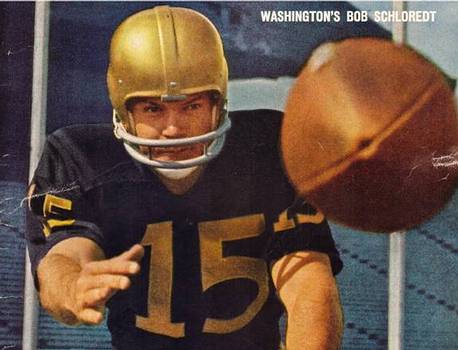

"Big Jim Owens"
HELMET HUT NEWS/REFLECTIONS JULY 2009:
Big Jim Owens
By Dr. Ken
Year by year, and as expected, the coaches I was privileged to play for and the coaches I was familiar with due to their nationally known exploits, pass on. If the generation of players I am a part of is now in the early to mid-sixties in age, that would place almost all of these coaches in their mid-seventies or older. Thus, as time moves forward, month by month we become aware of their passing. Most of the college coaches of the late 1950’s to mid-1960’s had a military background and certainly it would have been unusual to find a collegiate coaching staff lacking at least one or two military veterans. I would be hard-pressed to think of a coach I had personal contact with that did not serve in the military. Typical was the 1964 Cincinnati staff where five of six coaches were service veterans. These men took what they had learned in the military service and applied it to their football players’ preparation. The nature of two-way play, an emphasis on hard nosed defense and run-oriented offenses, and the type of conditioning background the coaches brought from the military made for extreme running, calisthenics, and agility programs that brought everyone into camp in excellent physical shape. Three hundred pounders were rare in part because the volume of running and skill practice, and of course, actual game play required a great deal more running than the “modern game.” Excess body fat for the most part, would be eradicated or the player had little chance of earning playing time. The 330 pound belly bumping offensive linemen of today would have gassed out quickly and would then have been laughed off of the field despite their great talent.
One of the coaches who turned around a suffering University Of Washington football program was Jim Owens. Unfortunately, on June 6, 2009, he too died, at the age of 82. He was a standout player at Oklahoma for Bud Wilkinson and a terrific two-way end on the 1949 squad that completed their season undefeated, scored 399 points, and finished with a rank of second in the nation behind Notre Dame. Owens play on both sides of the ball helped the Sooners finish first in rushing defense and second in rushing offense, a rare feat. After a season with the Colts and time invested in the pursuit of a law degree, he became an assistant under Paul “Bear” Bryant at Kentucky and then at Texas A&M where he helped to install the infamous “Junction Boys” conditioning regimen that he eventually brought to the University Of Washington as a twenty-nine year old head coach. Toughness, esprit de corps, and discipline became the hallmarks of the Huskies program.
 |
All American QB Bob Schloredt led the 1960 Rose Bowl team
The “Death March” mid-week, in-season session became a standard that brought Washington and Owens a reputation as having perhaps the hardest of the hard-nosed programs, especially on the West Coast that had an unfair reputation of playing “soft” football. One of the most inspiring aspects of the weekly conditioning day was that Owens would run all of the drills with his players! He introduced the “challenge system” to the West Coast, a staple in the South and Southwest where any player could request an opportunity to physically whip the man slotted ahead of him at his position in order to move up the depth chart.
|
|
Owens began his Washington run with a 3-6-1 record in 1957, followed with a 3-7 mark in ’58 and then had his recruits and the playing style he desired. He took the Huskies to a 10-1 record in 1959, one that included a 44-8 thrashing of Wisconsin in the Rose Bowl. A second Rose Bowl victory and 10-1 season in 1960 put West Coast football on the map after years of denigration. A loss to Dick Butkus’ Illinois team in the Rose Bowl following the 1963 season was the last real high point of Owens’ Washington career that went through the 1974 season but his teams were always competitive and tough. With a final record of 99-82-6, he was very successful relative to the recruiting and talent challenges he faced against the likes of USC and UCLA. The significance of Owens’ accomplishments and Washington’s success on the national level were related to the abrupt fall and lack of respect afforded to West Coast football, after undergoing the embarrassment of extensive recruiting scandals and the deconstruction of the existing conference that housed the major Coast football schools. Thus it was Owens’ Huskies teams that resurrected the areas gridiron fortunes. Owens further enhanced his reputation by serving as Washington’s Athletic Director from 1960 through ’69.
|
|
Another Owens’ All
American Quarterback, Sonny Sixkiller, 1971
Unfortunately, there
was controversy related to race relations within the program. Even in
Owens’ early years, whether true or not, there was a belief among some
of the African American players that although Washington showed no
hesitation to recruit minorities, there was a trend to stack them at
specific positions. In 2003 a statue was dedicated to the former coach
that was placed outside an entrance to Husky Stadium. This stimulated
protests from some minority groups and they noted racial turmoil on the
Washington teams of the late 1960’s including the 1969 suspension of
players that resulted in a 1-9 record and a great deal of animosity in
the area’s African-American community. Owens offered the following
apology, stating, "To my players, I thank them and apologize for any
hurt they may feel. I hope today we can begin to heal the wounds of the
past." Many believe Owens to be one of the foremost coaches of his era
due to the incredible level of spirit and enthusiasm his teams displayed
and the introduction of extreme conditioning methods to the West Coast.